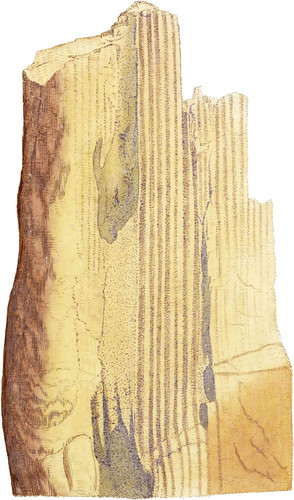 Enlarge
Enlarge
British Mineralogy
Wood-like Quartz, or Petrified Wood
- Class 2. Earths.
- Order 1. Homogeneous.
- Gen. 4. Silex.
- Spec. 1. Quartzum.
- Div. 2. Imitative.
Petrified Wood is by no means uncommon. It is, however, equally curious with many rarities, in showing some of the phænomena of the creation. Thus we find, when one substance passes away, another takes its place. This is an excellent evidence that when one substance passes to decay it forms and organizes others. The water that once assisted in the rise and flourishing verdure of the wood when in youth and health, now, in decay, helps to introduce a new substance in its place, and with such nicety that it is quite a deception. The colour and external appearance are still the same, although turned to stone; and the parts of the Wood, Hydrogen and Carbonic Acid are now evaporated.
This specimen was brought from Fonthill in Wiltshire by A. B. Lambert, Esq., V. P. L. S. It was eighteen inches in length, and twelve inches in circumference, and is one of the best specimens I have seen to show the nature of the change of place, viz. the Silex replacing the carbonaceous principle of the wood ; the Silex in solution, as it were, taking place of the former substance particle by particle. It is admirable to see the longitudinal and transverse fibres so perfectly arranged and coloured, with so little disturbance, that the very cracks and broken parts are detected with the utmost precision. Possibly the Oxide of Iron, or colouring substance, does not evaporate with the other principles: thus the colour of the parts is identically preserved. The specimen is externally somewhat granular, with the appearance of a fine-grained compact Sandstone, more dense in the centre, resembling Flint, and in some parts almost Opal*.
I have received specimens of this nature from Ireland, through the kindness of Dr. Scott and Mr. Templeton, and from Warwickshire by favour of Lady Aylesford, variously stained, and otherwise acted upon in the same piece, showing that the Wood had been more or less decomposed, or was decomposing in different parts, before the metamorphosis had taken place. Since the above was written His Grace the Duke of Bedford has favoured me with a curious and interesting piece of Petrified Wood, from Aspley, which has the hollows left by some insect very perfect. A most remarkable specimen of this kind, is described in Dr. Smith’s Tour on the Continent, v. 3. 113.
- * Wood wholly opalized is sometimes found.

